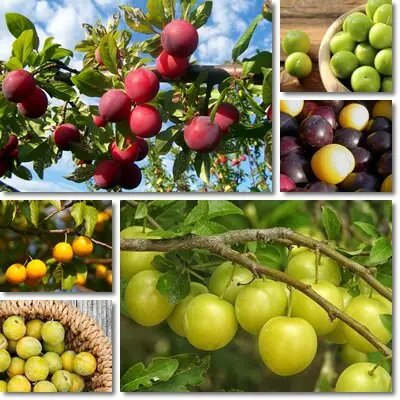The cherry plum, also known as the myrobalan plum (Prunus cerasifera) is a tree species and fruit in the plum family. It is a highly prolific fruit bearer and an ornamental tree found throughout Britain and its surrounding islands, Southeast Europe and Western Asia. Its fruits are an important source of pectin fiber and used to make jams, sweet and tart fruit sauces, tarts and pies. Fermented fruit are used to make a type of spirits called ‘eau de vie’ (literal translation: ‘life water’). Cherry plums boast a nutritional profile similar to that of plums and are important sources of antioxidants and vitamin C.
What do cherry plum trees look like?
The cherry plum tree (Prunus cerasifera), also known as the myrobalan plum tree, is related to plums, cherries, apricots and peaches. The tree grows to about 8-9 meters in height, but certain specimens can reach impressive heights of up to 12 meters. The bark is smooth, slightly shiny in younger trees, dark brown with reddish-brown hues. The leaves are typically either dark green or purple red and ovate. Cherry plum trees are usually the first to produce flowers in spring, as early as mid-February and up until mid-April, after which the leaves appear followed by fruiting. Flowers are white in specimens with green foliage and pink in specimens with purple foliage and look similar to plum or cherry blossom flowers.

What do cherry plums look like?
Cherry plums start off as oval, pointy and relatively slender green fruit. As they mature, they become round and plump-looking and grow to about 2 cm in diameter. There are two types of cherry plums: early season varieties that ripen in early summer, roughly from mid-June to mid-July, and varieties that ripen from early-mid July to mid-August or mid-September at the latest. Ripe cherry plums have a thin skin and extremely juicy, soft flesh. They can be golden yellow, orange-yellow, red, red-purple or dark purple in color. The skin is usually the same color as the flesh and each fruit contains one pit or stone in the center enclosing a bitter seed.
What do cherry plums taste like?
Some say cherry plums are less flavorful than plums, but this is not actually the case. In my experience, yellow cherry plums do indeed lack that intense fruity flavor we tend to expect of fruits, but are nevertheless sweet and pleasant-tasting, just more delicately flavored, or more straightforward sweet.
Red and purple cherry plums are much more flavorful, with a honey-sweet taste and fruity flavor notes complimented by a lovely tang. They are quite exquisite-tasting, with unique flavors dominated by sweet and sharp fruity notes and a rich flavor profile, not to mention a strong fruity scent. The secret to sweet and flavorful cherry plums is to water the tree during periods of drought or poor rainfall so the fruit become plump, juicy, soft and flavorful.
Can you eat unripe, green cherry plums?
Cherry plums are edible both ripe and unripe, while still green. The unripe green fruit are sour and astringent, having a puckering taste. They have a crisp, hard flesh of a light greenish color. You can eat unripe green cherry plums raw or cooked without any issues as they are generally safe to eat. The unripe fruit are commonly used to make sour soups and tart fruit sauces.
What do cherry plums smell like?
The fruit don’t have any noticeable smell until they become slightly overripe. As the natural sugars in cherry plums ferment from ripeness, the flesh develops a sweet, fruity aroma that envelops the senses. It isn’t until you bite into a perfectly ripe or even slightly overripe cherry plum that its overwhelming fruity scent is released in all its glory.

Plums vs mirabelle plums vs cherry plums
What is the difference between plums, mirabelle plums and cherry plums? The three look a lot alike, especially considering they are from the same family. But plums are usually larger, some varieties oval-shaped, pointy or with a soft groove along one side. Mirabelle plums not only look a lot like cherry plums, but they seem to be more closely related as species.
Vs cherry plums which are golden yellow, yellow and red, red, red-purple and dark-purple, mirabelle plums usually only come in one color, golden yellow and ripen in late August, not throughout the summer. Moreover, mirabelle plums are commonly speckled or turn orange-red on one side, where the sun catches them, while cherry plums tend to have quite a uniform color. They also have a slightly smaller stone than mirabelle plums.
What are cherry plums good for?
The cherry plum is used for making jams, sweet and tart sauces to accompany various dishes, spirits, fruit purees or to sour soups and other foods when unripe. It can be eaten as a snack on its own, right off the tree or added to fruit salads. As for its health effects, cherry plums have the following nutritional properties and health benefits:
1) Good for constipation and hemorrhoids
Cherry plums contain an estimated 1.4 grams of dietary fiber per 100 grams of fruit. Most of the fiber is located in the skin of the fruit and is both soluble and insoluble. Cherry plums are a particularly good source of a soluble fiber called pectin. In the digestive tract, pectin travels unchanged but absorbs water and becomes gel-like, which helps soften stools and relieve constipation. Soft stools that are easy to pass mean less strain during bowel movements which can improve hemorrhoids.
2) Natural prebiotic properties
The pectin in cherry plums is a soluble fiber, indigestible plant material that remains unchanged by digestive enzymes. Pectin ferments in the colon, releasing beneficial compounds that feed the good bacteria there, meaning it has prebiotic properties. These properties help maintain the health of the colon lining, support populations of good bacteria that help absorb nutrients from food and inhibit the growth of pathogenic gut bacteria, contributing to digestive health. Read more about the benefits of pectin.
3) Low in calories – good food for weight loss
Cherry plums have approximately 40 kcal (kilocalories, calories) per 100 g and less than 1% fat, making them a great good to eat for healthy weight loss. Moreover, they provide good amounts of dietary fiber which binds to some of the fat from the food we eat, reducing its absorption at the intestinal level. Dietary fiber further contributes to weight management via its satiating effect, helping curb hunger and promoting weight loss naturally.
4) Benefits for high cholesterol and cardiovascular health
As a source of fiber, cherry plums indirectly help lower LDL (bad) cholesterol levels and contribute to good cardiovascular health. Moreover, they are an extremely rich source of antioxidants which combat lipid peroxidation and further reduce risks of cardiovascular disease and associated cardiovascular events.
Dark colored cherry plums, red and dark red-purple fruits in particular, also contain pigmented anthocyanin antioxidants. Studies reveal anthocyanins have anti-inflammatory and free radical-scavenging effects in vitro and in vivo and help advance cardiovascular health.
5) Source of vitamin C for good immunity
Ripe cherry plums provide anywhere between 10% and 20% of the RDI (recommended daily intake) of vitamin C, while the unripe fruit may contain up to several times the amount. Vitamin C has strong antioxidant activities and has been shown in studies to actively reduce markers of inflammation in the body. Limiting inflammation both regulates the immune system response, preventing an excessive reaction, and represents a protective factor against chronic disease.
Research also shows vitamin C is used by different types of immune system cells to perform their functions within the immune system, contributing to a good immune system response and immune system support. Eating unripe cherry plums can help strengthen the immune system and combat respiratory infections.
However, the unripe fruit is also a natural source of citric acid which can cause stomach upset, acid reflux and worsen an existing gastritis or gastric ulcer if eaten in large amounts by those with severe acid reflux disease, gastritis or a peptic ulcer.
6) Rich in antioxidants
Studies show cherry plums have a high antioxidant content. The yellow varieties are sources of carotenes, while purple and red cherry plums have 4 to 6 different types of anthocyanin antioxidants (source: Antioxidant Activities and Major Anthocyanins of Myrobalan Plum (Prunus cerasifera Ehrh.)
The peel is especially high in antioxidants, but so is the deeply pigmented flesh of dark red and red purple cherry plum varieties. Ideally, the fruits should be eaten minimally processed so as to preserve their natural beneficial properties as much as possible.
Overall, eating cherry plums can represent a source of important benefits for eyesight and skin, memory and learning, exert an anti-diabetic, anti-inflammatory and even anti-anxiety action, and contribute to a lower risk of chronic diseases such as cancer, obesity, type 2 diabetes, cardiovascular disease or degenerative diseases of the nervous system.
7) Stimulate appetite and have tonic properties
Cherry plums were traditionally eaten to help restore appetite and for their tonic, energizing effects owed to a sugar content of over 10 g of natural sugars per 100 grams of ripe fruit. As the fruit become overripe, the natural sugars in them start to ferment which causes overripe cherry plums to not just help boost energy levels, but also exert a mild laxative effect, when eaten in large amounts.
Other essential nutrients in the fruit include provitamin A from pigmented carotenoid antioxidants. The provitamin A antioxidants in varieties of yellow cherry plums are the same antioxidants that occur naturally in yellow carrots as well as yellow tomatoes and yellow watermelon.
Conclusion
There is little research on the nutritional value and health benefits of cherry plums. Overall, they are theorized to have a similar nutritional value to plums and recommended as a tonic food with energizing properties and benefits for constipation, stomach upset, hemorrhoids and digestive imbalances. Cherry plums are used for strengthening the immune system, restoring appetite, reducing inflammation and for their benefits for eyesight.
